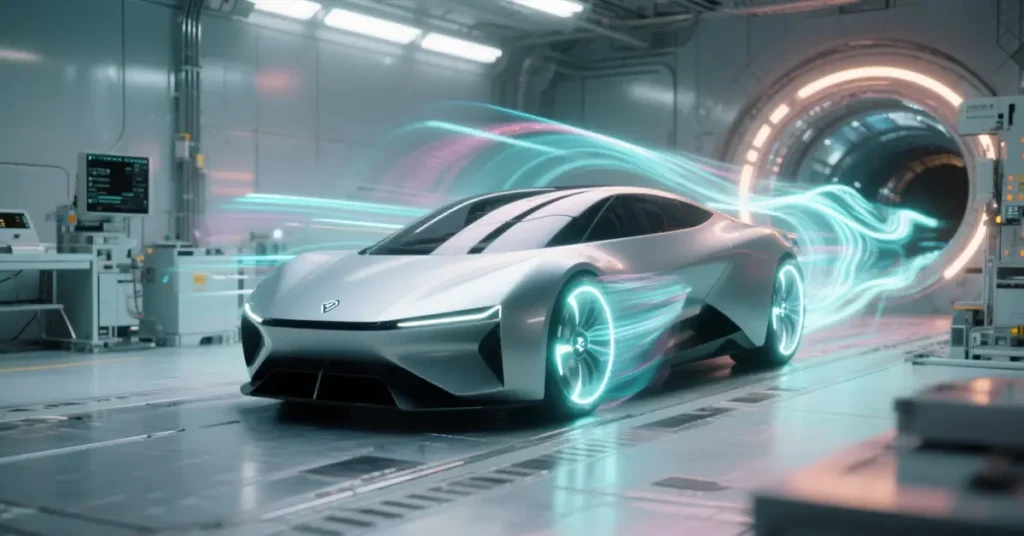When you think of the future of electric vehicles, you might imagine sleek shapes, high efficiency, and faster production times. But what if we told you that an open-source database from MIT could make all of this a reality sooner than you think?
MIT engineers have unveiled a groundbreaking dataset called DrivAerNet++ a massive digital library containing over 8,000 unique, AI-friendly electric vehicle (EV) designs. These aren’t just pretty 3D car models. Each one comes with rich aerodynamic data and engineering specifications that could transform how cars are designed and built in the near future.
Let’s dive into how this project works and what it could mean for the automotive world.
From Years to Minutes: Rethinking Car Design with AI
Designing a new car from scratch is a long, expensive, and painstaking process. Most major car manufacturers go through years of design cycles, digital renderings, wind tunnel tests, and prototype iterations before they arrive at a market-ready model.
MIT’s team, however, believes we can dramatically speed that up using artificial intelligence but AI needs data. Lots of it. And that’s where DrivAerNet++ comes in.
This new dataset serves as a training ground for generative AI models, allowing them to learn from thousands of design variations and aerodynamic simulations. The result? AI systems that can eventually generate brand-new EV designs in just seconds, cutting down years of R&D into mere hours.
What’s Inside the DrivAerNet++ Database?
This isn’t your average 3D car model collection. DrivAerNet++ contains:
- Over 8,000 unique EV body designs
- 39 terabytes of data
- Designs covering multiple vehicle body types
- Detailed formats like mesh structures, point clouds, and spec sheets
- Full aerodynamic simulations for each model
Each design was generated using an algorithm that systematically tweaked 26 different vehicle parameters everything from vehicle length and underbody geometry to tyre tread shapes and windshield angles. The goal was to cover as wide a design spectrum as possible, then calculate how each would perform in the real world using advanced fluid dynamics simulations.
This enables researchers and carmakers to instantly know how a design performs before ever building a prototype.
Why This Matters for the Future of EVs
1. Better Range, Faster
Aerodynamics directly affect a car’s efficiency and driving range. More aerodynamic shapes reduce drag, allowing EVs to travel further on the same battery. With this dataset, AI can now generate or test vehicle shapes that are more efficient without starting from scratch every time.
2. Lower Development Costs
Traditionally, aerodynamic testing is costly. Car manufacturers typically run physical or digital simulations on a few hand-designed concepts due to time and resource constraints. DrivAerNet++ offers a shortcut designs are already simulated, saving millions in R&D costs.
3. Accelerating Climate Goals
More efficient vehicles can reduce energy consumption and extend battery life. By bringing these designs to production faster, manufacturers can introduce greener, more sustainable EVs into the market more quickly helping to reduce carbon emissions on a global scale.
From Data to Design: How AI Makes Use of This Database
One of the biggest problems with early AI design tools was the lack of robust training data. Sure, AI could come up with sleek shapes, but without data on how those shapes perform in the real world, they were little more than digital sculptures.
DrivAerNet++ changes the game. Now, AI models can be trained not just to generate new car designs, but also to simulate their aerodynamic behavior, allowing carmakers to:
- Predict a vehicle’s drag coefficient
- Estimate its energy efficiency
- Assess range potential under different conditions
This allows manufacturers to optimize for performance, comfort, and sustainability before they even build a prototype
The Bigger Picture: AI’s Role in Automotive Innovation
This isn’t just a win for researchers or MIT. It’s a powerful resource for automakers, tech companies, startups, and even governments. As the automotive world shifts toward electrification and automation, AI is becoming a central tool not just in vehicle software but in vehicle design itself.
Initiatives like DrivAerNet++ open the door for more accessible and collaborative innovation, particularly through open-source data sharing. And in an industry where intellectual property often slows down progress, MIT’s move to make this public could lead to breakthroughs in global EV development.
Final Thoughts
What we’re witnessing isn’t just the next chapter in EV design it’s a new era in how vehicles are created. With datasets like DrivAerNet++ and powerful AI tools, manufacturers can break free from old design constraints and innovate at a scale and speed previously unimaginable.
We’re heading into a future where the question isn’t “What can we design?”, but “How fast can we bring great designs to life?”
MotorHub is your go-to platform for automotive insights, expert diagnostics, and smarter car care solutions. Whether you’re a car owner or a workshop, we keep you informed about the future of mobility from the roads of today to the innovations of tomorrow.



